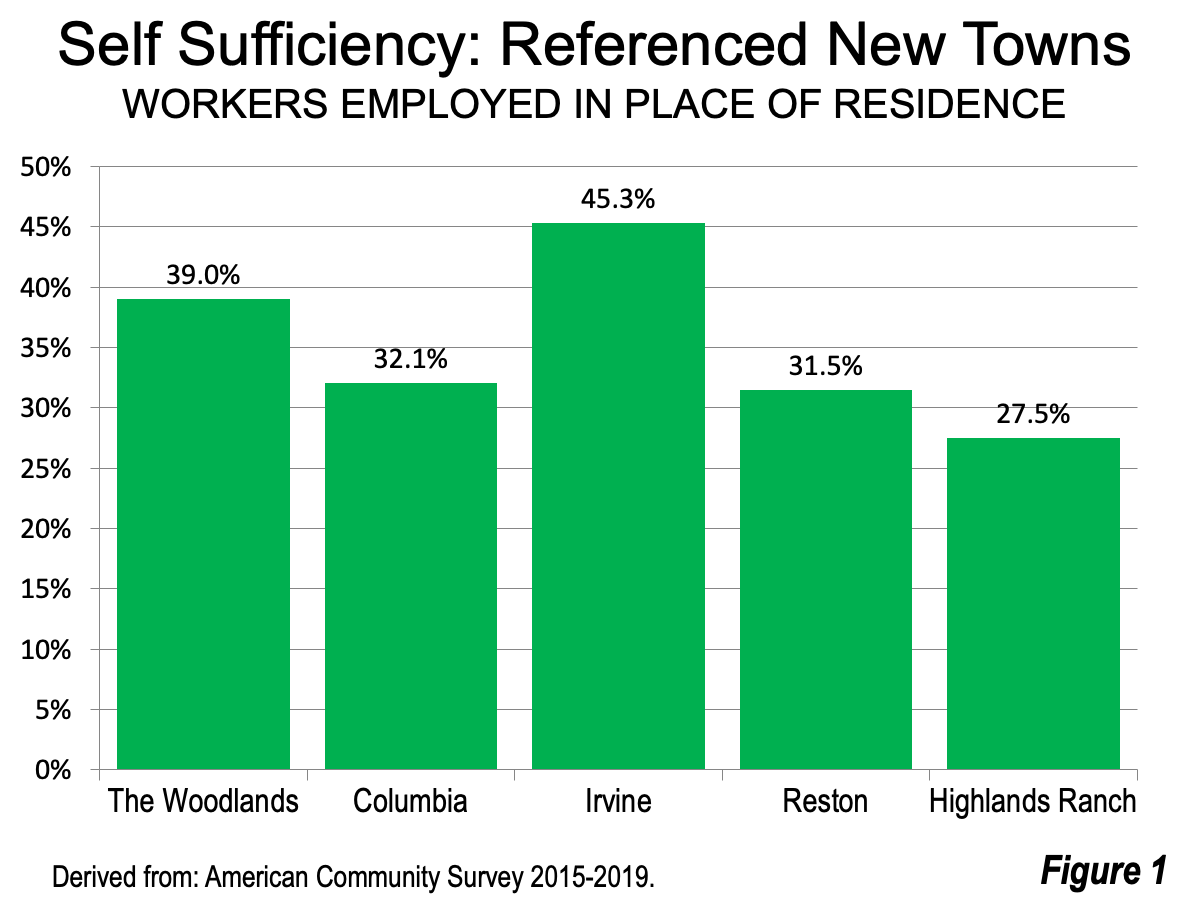
In the middle of the 20th century, there was considerable interest in developing new communities (new towns). The interest was, to some degree, driven by the establishment of new towns in nations like the United Kingdom and France, where a number of projects had been completed by 1970. This article is partially adapted from a report on issues related to the potential incorporation of The Woodlands Township, Texas (Note). Among the five new towns discussed, only Irvine, California has been incorporated as a municipality. The other four are census designated places (CDPs).
The new community vision in the United States was summarized in 1976, in New Communities U.S.A by Dr. Raymond Burby and Shirley F. Weiss at the Department of City and Regional Planning at the University of North Carolina at Chapel Hill.
There is general agreement that new community plans should include a variety of land uses so that provision is made for most of the necessities of urban life. That is, rather than depending on the surrounding region for employment opportunities and services, the new community should be as self-sufficient as possible. Self–sufficiency is attained through size. The community must be large enough to support complex service systems and maintain balance, by consciously setting aside land for industrial, commercial, public, recreational, and institutional functions that are appropriate to the expected population.
There was great hope for new communities. In the late 1960s, the National Committee on Urban Growth Policy recommended building 100 new communities of 100,000 residents each and 10 new towns of 1,000,000 residents. In the end, few were built, including four discussed in this article (The Woodlands, TX; Columbia, MD; Reston, VA; and Highlands Ranch, CO), as well as Irvine, CA. Among these, only Reston failed to achieve a population of 100,000 or more.
A federal program, the Urban Growth and New Development Act of 1970designated 13 new communities and provided financial support. It was a financial failure as all but one of the new communities defaulted on their federal obligations The exception of was The Woodlands in the Houston metropolitan area founded by the visionary George Mitchell. Further, none of the proposed million population new communities were developed. Even so, the few successful new communities had influence on the patterns of suburban development that continues to this day.
The first of the completely new communities that survived was Columbia, Maryland in the Baltimore metropolitan area, developed by James Rouse, starting in the early 1960s. Columbia, along with The Woodlands; Reston, Virginia (Washington metropolitan area); Highlands Ranch, Colorado (Denver metropolitan area) and Irvine, California (Los Angeles metropolitan area), are often considered among the premier new communities in the United States. Each of these communities was developed largely with private financing, only the Woodlands was a recipient of Urban Growth and New Development Act funding.
George Mitchell was significantly influenced by James Rouse, the developer of Columbia and Maryland. Mitchell and the other visionaries wanted the new communities to be larger developments, rather than the smaller subdivision developments e more characteristic of suburbs in the United States, Canada, and Australia. They wanted to create communities with villages, separated by green areas, with generous amounts of open space (the “village concept”).
For Mitchell, there were goals to “maintain forest preserves along major roadways” and the green areas “along the natural streams” as well as establishing “a ‘complete’ community with a major employment center where one can ‘live, work, play and learn.’”
Urban planners have favorably reviewed The Woodlands and other new communities. An evaluation by Ann Forsyth, now at Harvard University noted that The Woodlands (as well as Columbia, Maryland and Irvine, California) conform to the “smart growth” and “new urbanist” design practices that are generally favored in urban planning, exhibiting “cutting-edge planning and design strategies. “This is despite their suburban locations which the planning community has long disdained.
Total self-sufficiency was not achieved in any of these places, but there was considerable growth in local employment. For example, among the five new towns mentioned in this article, Irvine, by far the largest, had the highest percentage of its workers employed within its borders (45.3%), according to American Community Survey 2015-2019 data, while Highlands Ranch has the lowest share, at 27.5% (Figure 1).

The average among the five new towns was 35.1%. By comparison, the average for the nearly 30,0000 “places” in the United States (municipalities and census designated places) was 21.5%.
Given that these areas are located in major metropolitan areas, employment self-sufficiency could not be achieved, as individuals still find their best opportunities elsewhere. This is because metropolitan areas are labor markets, and for many workers, the ideal job is outside their place of residence, no matter how well a town is planned.
In a labor market, resident workers have a far larger market of employment to choose from and will tend to take the jobs that best meet their requirements throughout the metropolitan area with commuting distance being only one factor. Yet, The Woodlands —like some other successful new communities (Columbia, Reston, and Irvine)— has been able to attract substantially more jobs than resident workers, while offering many residents the option of working closer to home. So, it might be argued that the new towns achieved theoretical self-sufficiency, but due to their locations in larger labor markets, residents were not likely to limit their job searches to the local jurisdiction.
The Woodlands is unique in having developed the second strongest employment base in the Houston metropolitan area, and as a result is included in its formal name (the Houston–The Woodlands–Sugar Land metropolitan area).
Self–sufficiency would have required building new communities far from existing labor markets so that resident employees would not be enticed into commuting to the outside. Even where ideally located, outside existing labor markets, coordinating job creation and new resident workers would be probably well beyond the capability of planning.
Despite the impossible expectations of employment self–sufficiency, these five new towns have made considerable progress in becoming successful places that offer not just employment opportunities, but significant natural and cultural amenities. If you are near such places, it might be worth looking into them.
Adapted from “Issues Relating to the Potential Municipal Incorporation of The Woodlands Township” (2021). Dr. Luis Torres, Wendell Cox & Joel Kotkin, Urban Reform Institute. Read/download the full report at Urban Reform Institute.
Note: The voters of The Woodlands rejected the proposed incorporation in November 2021.
Wendell Cox is principal of Demographia, an international public policy firm located in the St. Louis metropolitan area. He is a founding senior fellow at the Urban Reform Institute, Houston, a Senior Fellow with the Frontier Centre for Public Policy in Winnipeg and a member of the Advisory Board of the Center for Demographics and Policy at Chapman University in Orange, California. He has served as a visiting professor at the Conservatoire National des Arts et Metiers in Paris. His principal interests are economics, poverty alleviation, demographics, urban policy and transport. He is co-author of the annual Demographia International Housing Affordability Survey and author of Demographia World Urban Areas.
Mayor Tom Bradley appointed him to three terms on the Los Angeles County Transportation Commission (1977-1985) and Speaker of the House Newt Gingrich appointed him to the Amtrak Reform Council, to complete the unexpired term of New Jersey Governor Christine Todd Whitman (1999-2002). He is author of War on the Dream: How Anti-Sprawl Policy Threatens the Quality of Life and Toward More Prosperous Cities: A Framing Essay on Urban Areas, Transport, Planning and the Dimensions of Sustainability.
Photo: The Woodlands Township central business district via Wikimedia under CC 4.0 License












